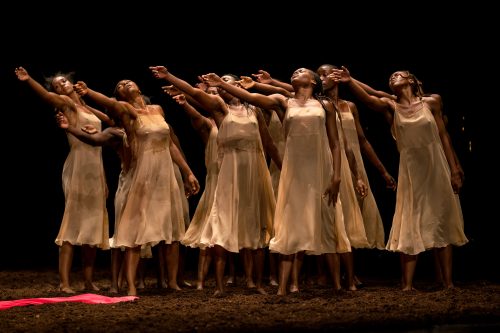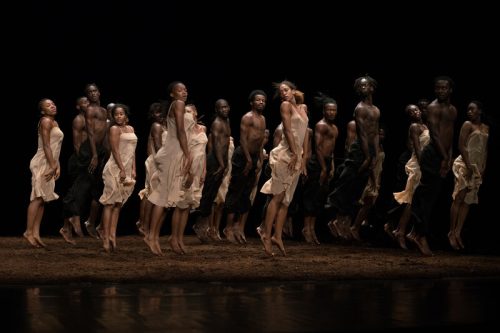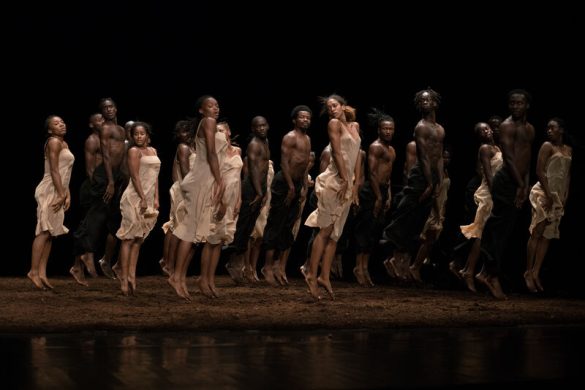
 United Kingdom Edinburgh International Festival 2023 [9] – Pina Bausch’s The Rite of Spring and Germaine Acogny and Malou Airaudo’s common ground[s]: Edinburgh Playhouse, 17.8.2023. (SRT)
United Kingdom Edinburgh International Festival 2023 [9] – Pina Bausch’s The Rite of Spring and Germaine Acogny and Malou Airaudo’s common ground[s]: Edinburgh Playhouse, 17.8.2023. (SRT)

common ground[s]
Co-Choreographers and Dancers – Germaine Acogny and Malou Airaudo
Composer – Fabrice Bouillon LaForest
Costume designer – Petra Leidner
Lighting designer – Zeynep Kepekli
Dramaturg – Sophiatou Kossoko
The Rite of Spring
Choreographer – Pina Bausch
Composer – Igor Stravinsky
Set and Costume designer – Rolf Borzik
Collaboration – Hans Pop
Restaging Artistic Directors- Josephine Ann Endicott, Jorge Puerta Armenta and Clémentine Deluy
A Pina Bausch Foundation, École des Sables & Sadler’s Wells production
Pina Bausch’s production of The Rite of Spring had its UK premiere at the 1978 Edinburgh International Festival. This recent version had a rather more tortured journey here thanks to lockdowns of 2020, and even this pairing’s Sadler’s Wells production of 2022 was shorn of one of its parts due to Covid. It is here now, though, and marks with style the return of the festival’s dance programme to the Edinburgh Playhouse.
This new production comes from The Pina Bausch Foundation and Sadler’s Wells but also, importantly, the pan-African company École des Sables. All the movement is Bausch’s original, but all the dancers are African, drawn individually from countries the length and breadth of the continent. That matters as it gives this Rite a scope that takes it away from ancient Russia and into the universality of man alone in any unforgiving landscape.
That universality also comes through in the body language of the dancers. The movement in Bausch’s Rite is marked by terror and anxiety right from the start, as dancers exist alone in the spotlit darkness, jerking and writhing in tortured isolation from one another. The community as a whole makes its presence felt, but it is an intimidating, unforgiving group. The women dress in white slips while the men dress in black, marking out their differences in the same way that their groups of movements do, and that sense of isolation feeds into central moment of The Rite, the choice of a girl to dance herself to death for the gods of Spring.
That takes us to the staging’s other key ingredient: the all-important earth. The floor is nothing other than an empty square, but it is covered in a layer of soil that links the participants quite literally to the earth. The earth thus becomes both a comforting cushion and a source of the climactic danger. Bausch’s choreography constantly requires the dancers to dance as though they are at the very end of their tethers – they don’t know which of them is about to die, after all! – and as they writhe and thrust the soil clings to their sweat-soaked bodies, adding an extra layer of colour and depth to the atavistic darkness of the staging.

It is impossible to take your eyes off what amounts to a gripping piece of theatre. Bausch creates a loveless environment characterised by fear, where selfishness and coldness rules the human relationships. The climax of this is the ritualistic dressing of the Chosen One in red while everyone around her goes berserk, a riveting moment. But every crowd scene contains moments that lead up to that, such as the majestic circular round dance, or a spine-tingling moment where several women dance alone as individuals before retreating, terrified into the crowd again. The group watches in chilling silence as the victim dances herself to death in a tour-de-force of physicality, the final exploration of the individual collapsing in the face of her society.
It is unimaginable that anything that could face up to this in power, and the choice of companion piece was unavoidably thin. common ground(s) is an extended duet danced by Malou Airaudo, a dancer who worked with Pina Bausch, and Germaine Acogny, co-founder of the École des Sables. Both women share the stage in dance that moves from smooth fluidity to jagged isolation, creating a piece that, like The Rite, explores theme of isolation and togetherness, albeit in a rather more sedate manner. It was interesting in its way, and Fabrice Bouillon LaForest’s original score picks out a musical landscape of bare harmonies and prickly melodies to accompany them. Once the animalistic energy of Bausch’s Rite hit, though, it all but swept its predecessor out of my memory.
Simon Thompson
To 19 August; for information click here.
